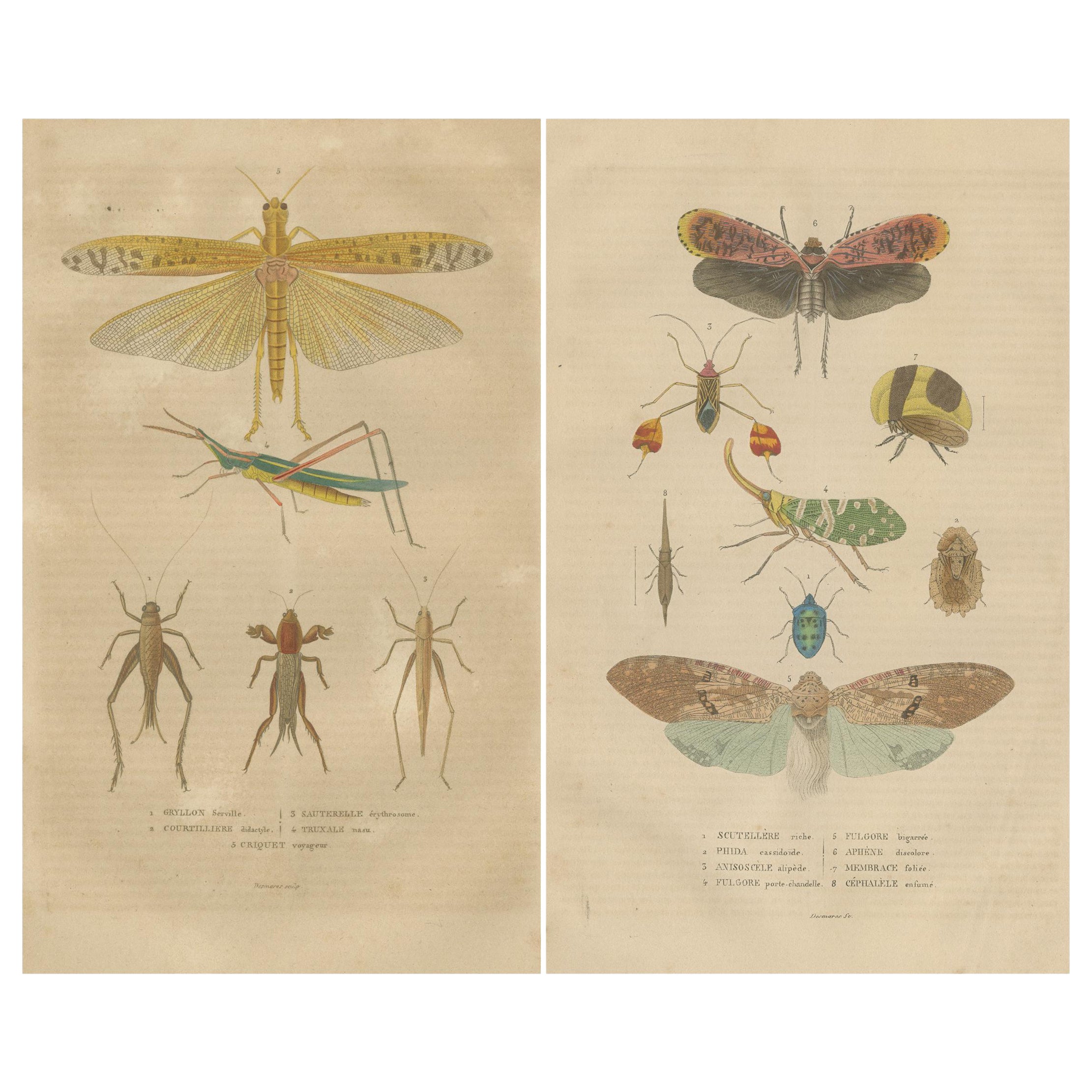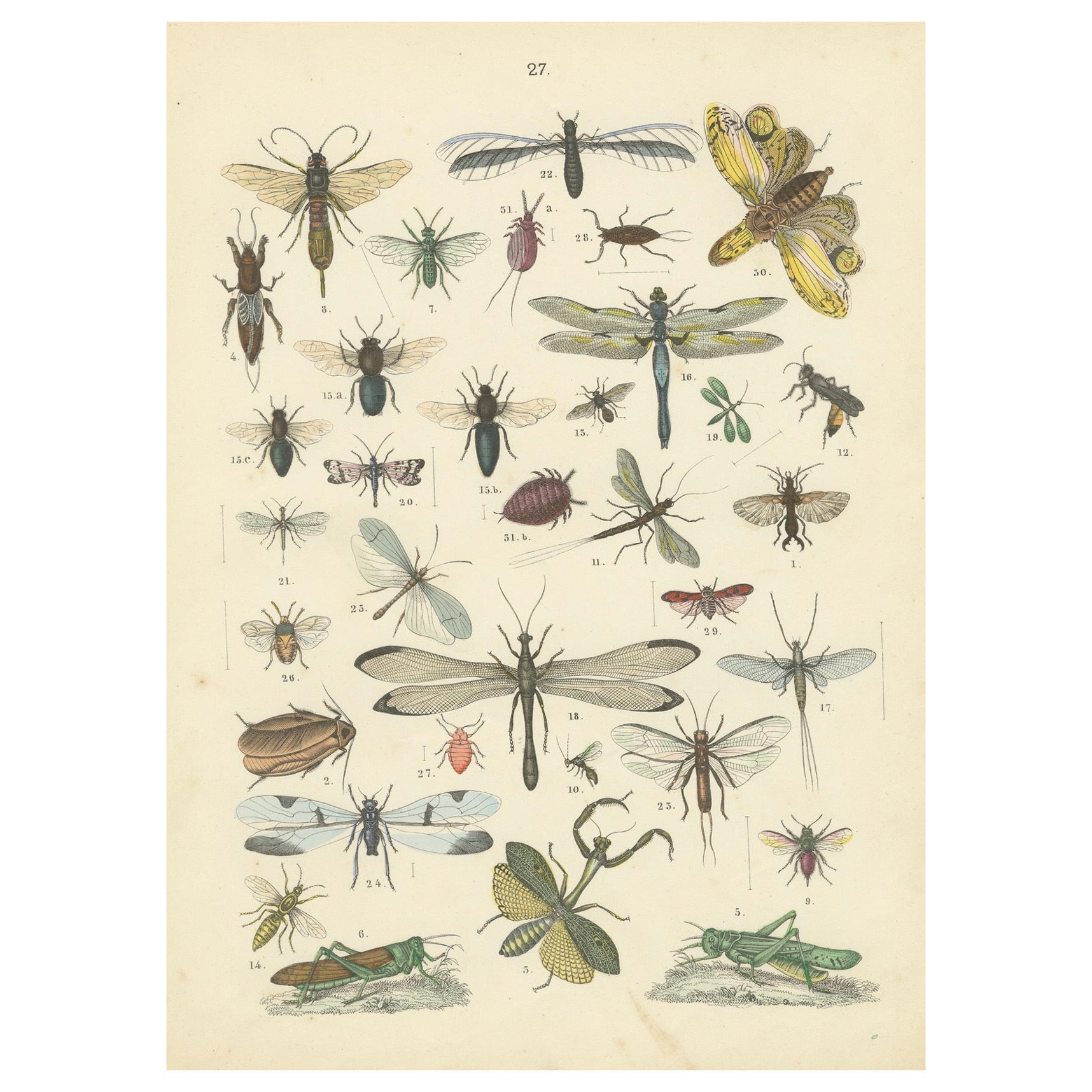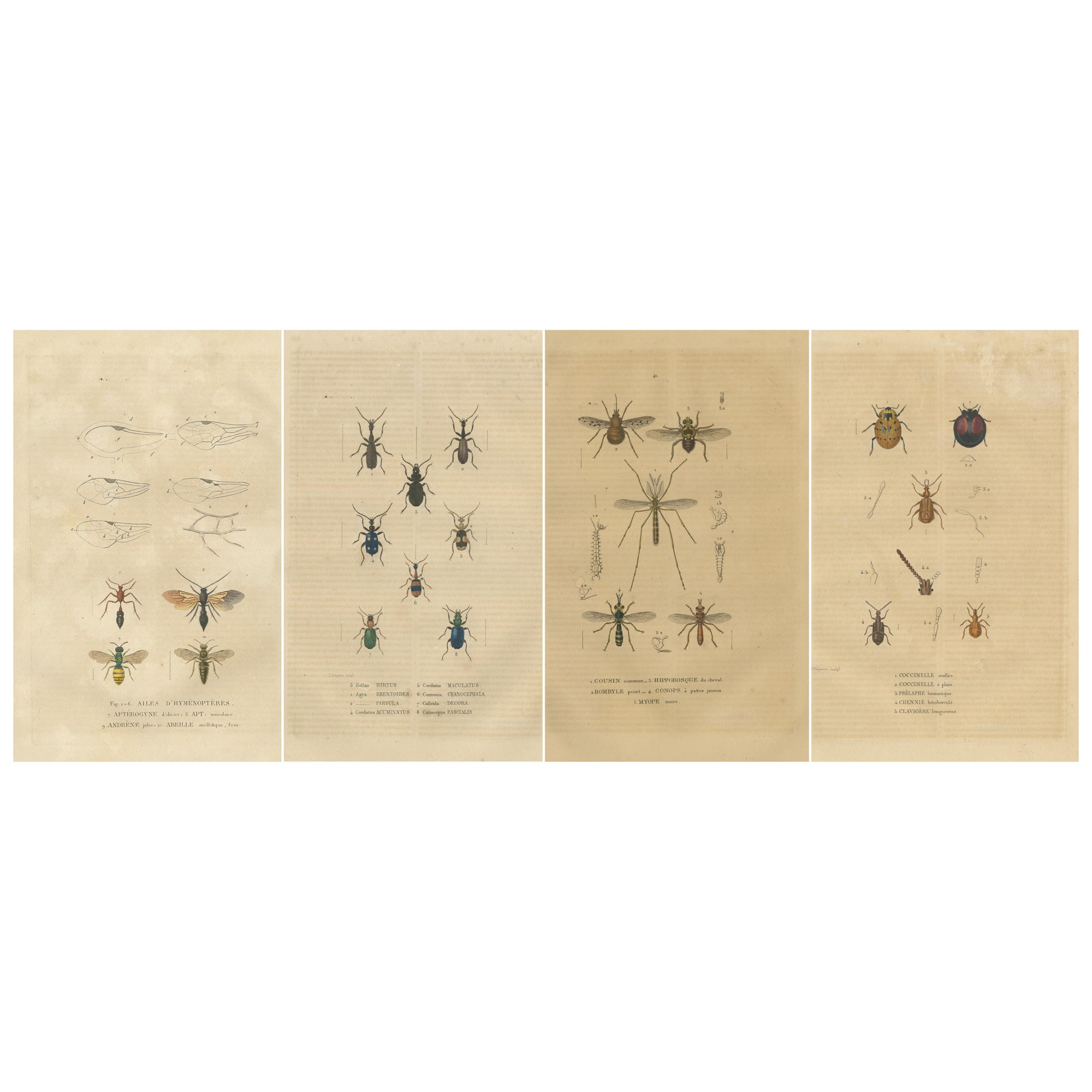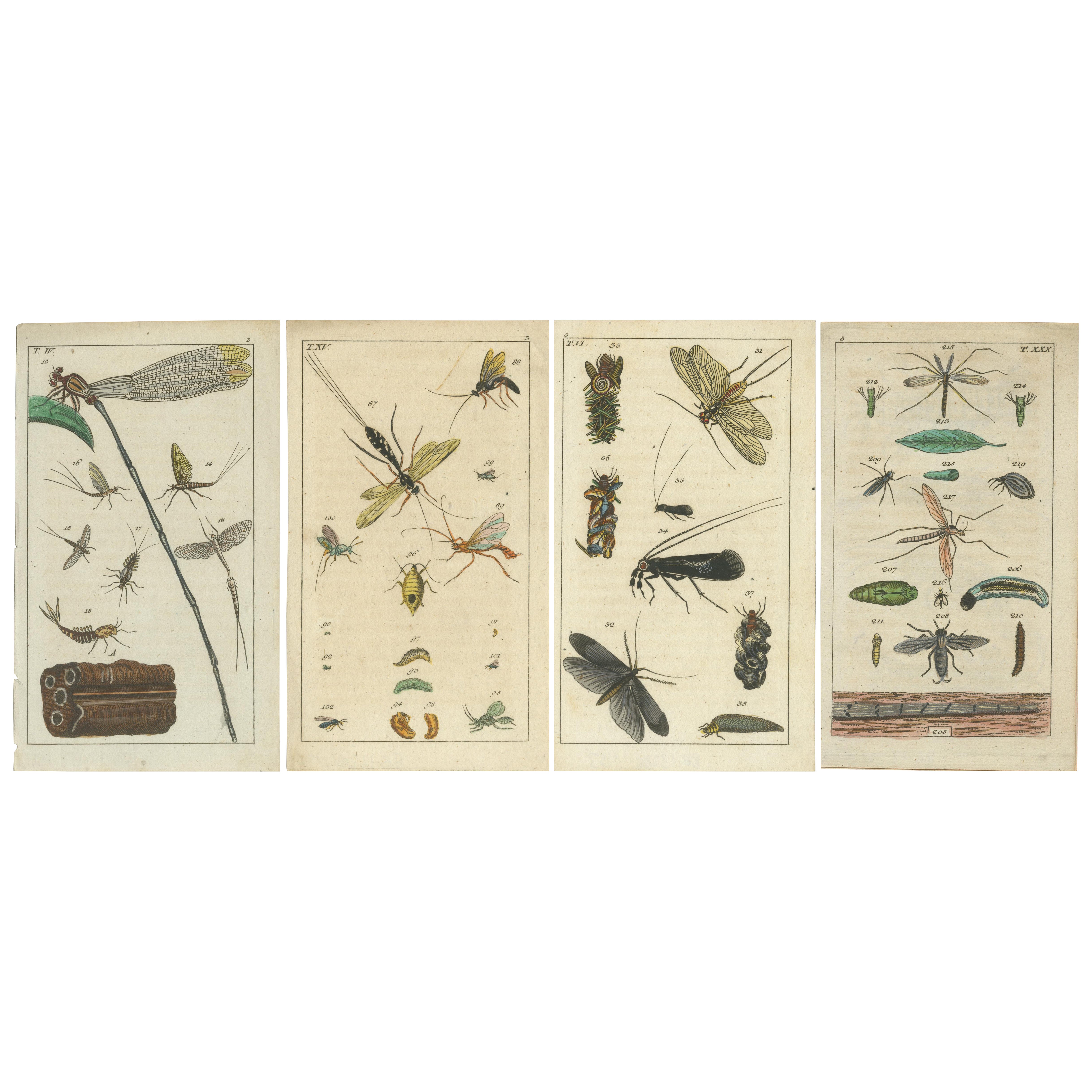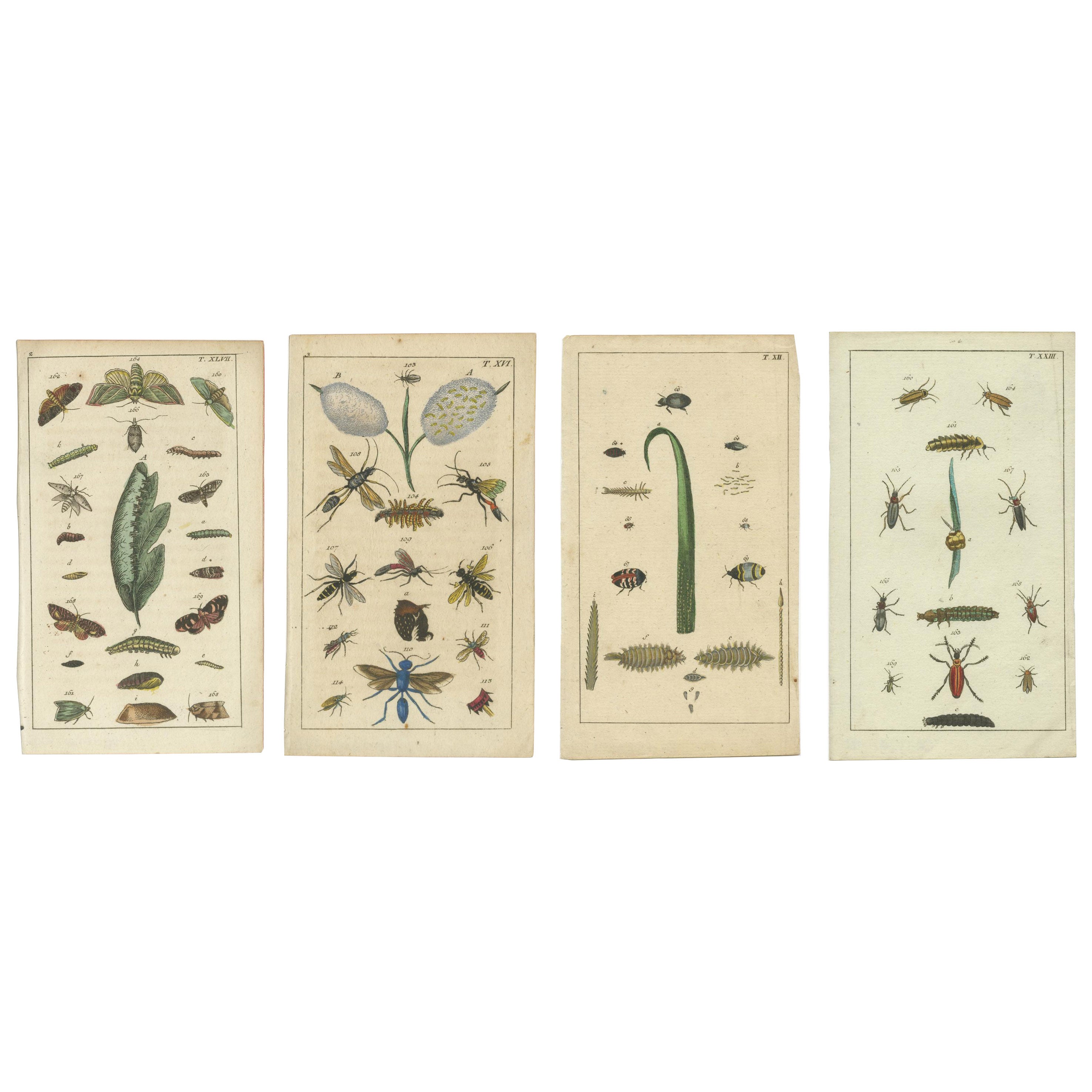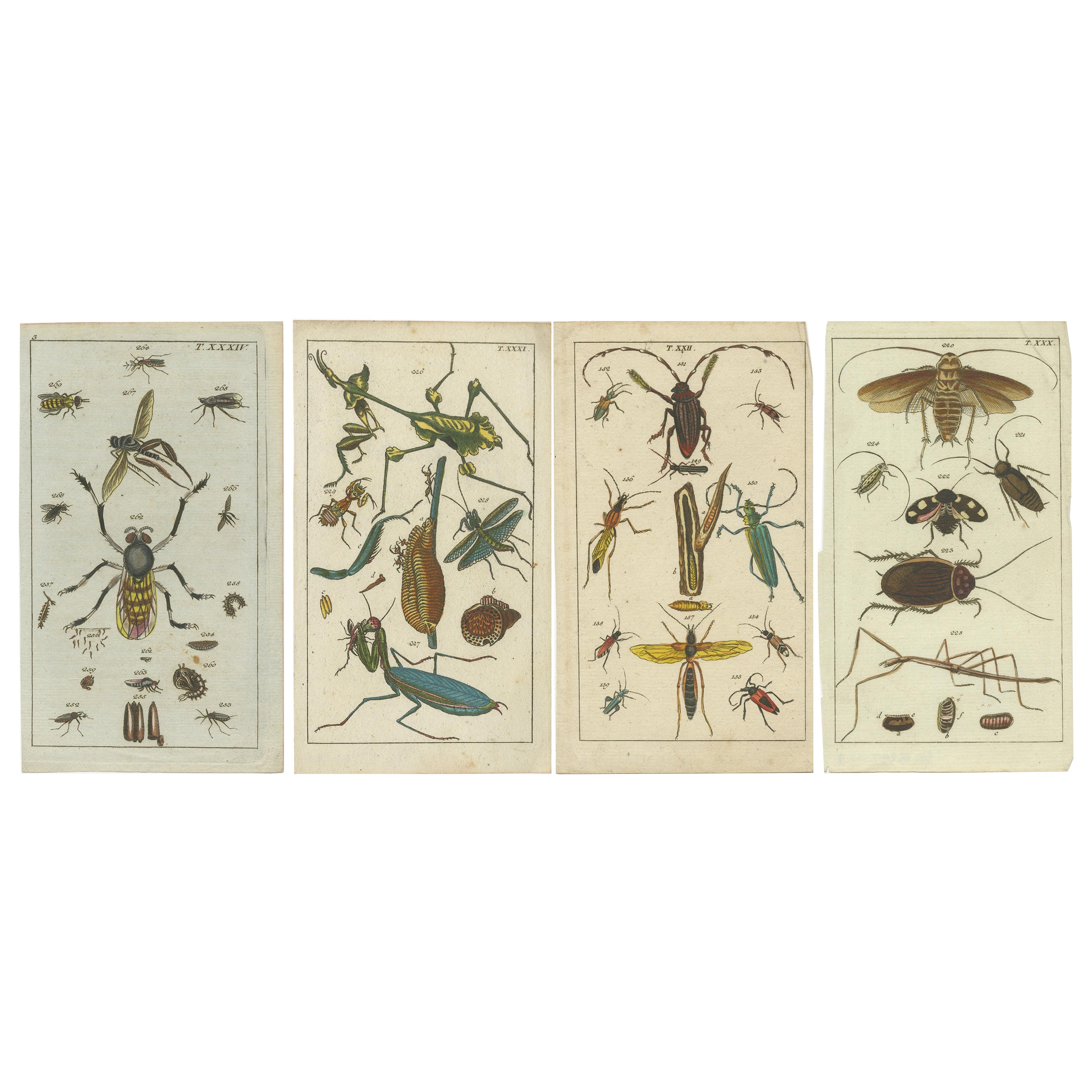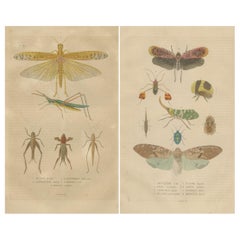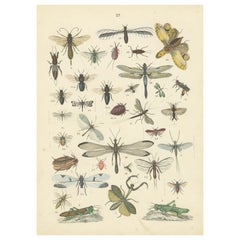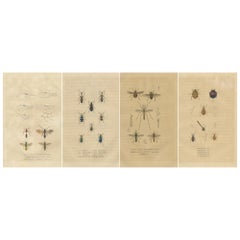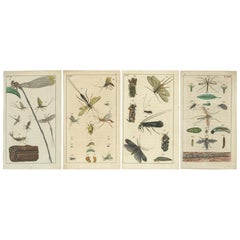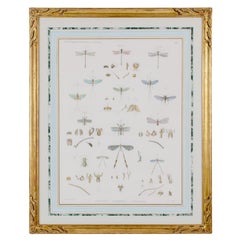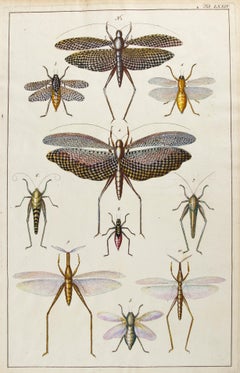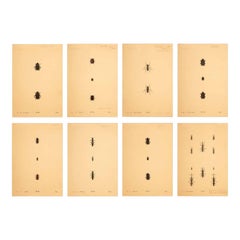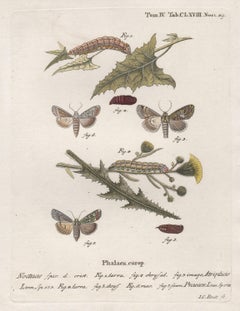Items Similar to A Study of Winged Insects: An Entomological Collection from the 18th Century
Want more images or videos?
Request additional images or videos from the seller
1 of 6
A Study of Winged Insects: An Entomological Collection from the 18th Century
$310.40
£231.61
€260
CA$432.84
A$474.19
CHF 247.71
MX$5,700.70
NOK 3,096.76
SEK 2,920.74
DKK 1,979.85
About the Item
This original hand-colored antique print shows a variety of flying insects, commonly found in entomological reference works. Each insect is labeled with a number, and corresponding names are provided at the bottom of the image. Here are the names of the insects as labeled in the image:
1. **Libellule déprimée** - This likely refers to a species of dragonfly, known for their large eyes and two pairs of strong, transparent wings.
2. **Éphémère vulgaire** - Commonly known as mayflies, these insects are characterized by their short lifespans and delicate wings.
3. **Panorpe commune** - This is likely a scorpionfly, recognizable by their elongated faces and the males' curled tails that resemble a scorpion's stinger.
4. **Névroptère à balanciers** - This could refer to an insect within the Neuroptera order, possibly a lacewing, known for their intricate wing venation and long antennae.
5. **Fourmilion** - Also known as antlions, these insects are known for the predatory habits of their larvae, which create pits in sand to trap ants.
6. **Ascalaphe italien** - This is another insect from the Neuroptera order, perhaps a species of owlflies, which are known for their clubbed antennae and large eyes.
7. **Hémérobe chrysopa** - Commonly called green lacewings, these insects are beneficial as they feed on aphids and other garden pests.
8. **Raphidie serpent** - Likely referring to snakeflies, they have elongated prothoraxes and are predatory insects.
9. **Psocque à deux points** - This could refer to a species of bark lice or booklice, known for living in bark or old books.
10. **Pérlide à deux queues** - This is likely a stonefly, which is found near clean, fast-running water and has two tail-like appendages.
The print is a typical representation of entomological studies from the 18th and 19th centuries, where detailed illustrations were crucial for the study and classification of insects. The style suggests it may have been created for a scientific book or collection. The labels are in French, and the terms used may be either outdated or using older nomenclature, as common names and scientific understanding of these species have evolved.
This print not only serves as a scientific record but also as a work of art, reflecting the dual interests of the Victorian era in both natural history and illustration. It is a remarkable piece that would be a significant addition to any collection of natural history art or an elegant decorative piece for those with a taste for the historic and the natural world.
The style of the illustration is reminiscent of 19th-century scientific prints, which were often used in natural history books to document various species.
More info on the book in which it was published:
The 'Dictionnaire Classique des Sciences Naturelles' by Pierre Auguste Joseph Drapiez stands as a remarkable testament to 19th-century natural sciences. Published in Brussels in 1845, this work represents an expansive collation of knowledge, building upon the pioneering works of Buffon, Daubenton, Lacepede, Cuvier, de Jussieu, and other influential naturalists.
The prints within this compendium likely showcase a rich amalgamation of artistic precision and scientific accuracy. Drapiez, himself a Belgian naturalist, would have aimed for detailed representations of flora, fauna, and scientific phenomena, mirroring the illustrative styles prevalent during his time. Given the era's emphasis on illustration, these prints were likely engraved meticulously, possibly portraying intricate anatomical details or lifelike depictions of the natural world.
With Drapiez's background in natural history, the prints might bear testament to his commitment to scientific authenticity, aiming to educate and inspire scholars and enthusiasts alike. These engravings would have complemented the text, offering visual aids that elucidate the concepts and specimens discussed in the volume.
Overall, the prints of 'Dictionnaire Classique des Sciences Naturelles' likely serve as both artistic representations and invaluable scientific resources, encapsulating the essence of 19th-century natural history exploration and documentation.
- Dimensions:Height: 10.44 in (26.5 cm)Width: 6.7 in (17 cm)Depth: 0 in (0.02 mm)
- Materials and Techniques:Paper,Engraved
- Period:
- Date of Manufacture:1845
- Condition:Condition: Good. Light browning and some light spots due to aging and handling. Light offset from a opposite text plate in the original book. Please study scan carefully.
- Seller Location:Langweer, NL
- Reference Number:Seller: BG-13261-751stDibs: LU3054337751112
About the Seller
5.0
Recognized Seller
These prestigious sellers are industry leaders and represent the highest echelon for item quality and design.
Platinum Seller
Premium sellers with a 4.7+ rating and 24-hour response times
Established in 2009
1stDibs seller since 2017
2,654 sales on 1stDibs
Typical response time: <1 hour
- ShippingRetrieving quote...Shipping from: Langweer, Netherlands
- Return Policy
Authenticity Guarantee
In the unlikely event there’s an issue with an item’s authenticity, contact us within 1 year for a full refund. DetailsMoney-Back Guarantee
If your item is not as described, is damaged in transit, or does not arrive, contact us within 7 days for a full refund. Details24-Hour Cancellation
You have a 24-hour grace period in which to reconsider your purchase, with no questions asked.Vetted Professional Sellers
Our world-class sellers must adhere to strict standards for service and quality, maintaining the integrity of our listings.Price-Match Guarantee
If you find that a seller listed the same item for a lower price elsewhere, we’ll match it.Trusted Global Delivery
Our best-in-class carrier network provides specialized shipping options worldwide, including custom delivery.More From This Seller
View All19th-Century Insectarium: A Glimpse into Orthoptera and Varied Insects
Located in Langweer, NL
The first print depicts a collection of orthopteran insects, which includes grasshoppers and crickets. These are characterized by their long hind legs for jumping, and in the case of...
Category
Antique 1840s Prints
Materials
Paper
$181 Sale Price / set
20% Off
Free Shipping
Insects Print: Dragonflies, Grasshoppers, Stick Insects & True Bugs – 1867
Located in Langweer, NL
Insects Print: Dragonflies, Grasshoppers, Stick Insects & True Bugs – Antique 1867
This fascinating antique print depicts a wide variety of insects, including dragonflies, grasshopp...
Category
Antique 1860s German Prints
Materials
Paper
Entomological Treasury: A Detailed Study of Insect Diversity, 1845
Located in Langweer, NL
A set of four antique engravings from the year 1845, depicting various insects in a detailed and hand-colored manner. These illustrations are from a scientific publication or a natu...
Category
Antique 1840s Belgian Prints
Materials
Paper
$181 Sale Price / set
20% Off
Small Natural History Prints: Insects and Life Cycles in Exquisite Detail, 1832
Located in Langweer, NL
Title: Stunning Antique Natural History Prints: Insects and Life Cycles in Exquisite Detail
Description: This set of four original antique prints, published in 1832, offers a capt...
Category
Antique 1830s Prints
Materials
Paper
Small and Rare Natural History Prints Featuring Insects and Plants, 1832
Located in Langweer, NL
Title: Rare 19th-Century Natural History Prints Featuring Insects and Plants
Description: This set of four original antique prints offers a captivating glimpse into the rich detail ...
Category
Antique 1830s Prints
Materials
Paper
Captivating Natural History Prints: Insects, Life Cycles and Rare Details, 1832
Located in Langweer, NL
Title: Captivating Antique Natural History Prints: Insects, Life Cycles, and Rare Details
Description: This set of four small original antique prints from 1832 offers an extraord...
Category
Antique 1830s Prints
Materials
Paper
You May Also Like
Large Engraving of Winged-Insects by J-Ces Savigny c.1812
Located in Savannah, GA
Marie Jules César Lelorgne de Savigny
(French, 1777-1851)
Offered is a framed hand-colored engraving by Savigny entitled “H.N. Zoologie Nevropteres”, plate 2 from Description de l'...
Category
Antique 1810s French Prints
Materials
Glass, Giltwood, Paper
Insect Engraving
Located in New York, NY
Seba, Albertus.
Locupletissimi rerum naturalium thesauri accurata descriptio, et iconibus artificiossimis expressio, per universam physices historiam.
Amsterdam, Wetsten, Smith, Jans...
Category
Mid-18th Century Prints and Multiples
Materials
Laid Paper
$575 Sale Price
23% Off
Unframed Collection Painted Scientific Illustrations of Various Insects
Located in New York, NY
Unframed Collection painted scientific illustrations of various insects from the early 20th century:
Each measures approximately: 8" x 6"
...
Category
20th Century Paintings
Materials
Paper
Esper Antique 18th century Butterfly engraving with original hand-colouring
By JC Bock
Located in Melbourne, Victoria
A German copper-line engraving with original hand-colouring of butterflies. Printed on hand made laid paper. Engraved by JC Bock.
From Eugenius Esper's "Die Schmetterlinge in Abbild...
Category
Late 18th Century Naturalistic More Prints
Materials
Engraving
Early XXth Century French Engraving of Insects
Located in Barcelona, ES
"Early XXth Century French Engraving of Insects"
Origin: France, early XXth century
Art Form: Engraving
Subject: Insects
Transport yourself to the fascinating world of ...
Category
20th Century French Mid-Century Modern Prints
Materials
Paper
$1,193 Sale Price
20% Off
Lepidoptera -Etching by Jean Francois Turpin - 1831
By Pierre Jean François Turpin
Located in Roma, IT
This is one of the illustrations of "Dizionario di scienze naturali" (Natural sciences dictionary) edited by Battelli nel 1831. The work was made of 29 volumes, containing hundreds ...
Category
1830s Modern Animal Prints
Materials
Etching
$167 Sale Price
30% Off
More Ways To Browse
Mid Century Shutters
Miyagawa Kozan
Monarch Table
Monkey Statue
Monstera Leaf
Murano Dove
Murano Folded Glass
Murano Glass Penguin
Murano Glass Picasso
Murano Gold Fleck Birds
Murano Parrot
Murano Penguin
Murano Red Fish
O Brien Used Furniture
Oggetti Murano Vintage
Ole Bjorn Kruger
Onyx 19th Century French Mantel Clock
Onyx Cube
